CONTENTS OF THIS PAGE
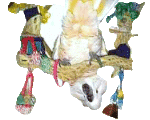
Basic Care
SIGNS OF ILLNESS IN YOUR PARROT
LINKS TO OTHER SITES FOR HEALTH INFORMATION, TOYS,
ETC.
LIST OF INTERACTIVE GAMES TO PLAY WITH
YOUR PARROT
INEXPENSIVE TOYS FROM STUFF AT YOUR HOME
RECIPES FOR YOUR FEATHERED FRIEND

Basic Bird Care
Birds are more than a bunch of
pretty feathers. Some smaller birds, like canaries, finches, and parakeets will be happy
to sit in a cage with toys to keep them busy. The larger birds need larger amounts of
attention, and more of your time. They can live from 20 to 80+ years, so they should
be considered a companion rather than a pet.When you adopt a parrot, consider it a new
family member since it will live as long as you do.
From "The Complete Idiots Guide to Bird Care and
Training"...
"A study by the American Veterinary Medical Association estimates that there are 56
million cats, 53 million birds, and 52 million dogs in American homes." |
| ROCKIE BITS
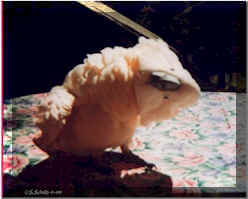
Rockie is a 3 yr. old male Moluccan Cockatoo.
We have been together since Nov. 1998. He weighs 861 grams and is 21" long. Birds
like Rockie are found in the rainforests of the Moluccan Islands in Indonesia, but Rockie
was born near Chico, CA. The Moluccan Cockatoo is endangered, and there are
thought to be less than 2000 still in the wild. This is due to excessive importation
and destruction of the rainforests they live in. |
INFORMATIONAL
TIDBITS PARROT, common name generally applied to members of the
large bird family Psittacidae; groups of parrots that have their own common names include
the cockatoos, lories, lovebirds, macaws, and parakeets. In length, parrots range from the
buff-faced pygmy parrot of New Guinea at 3 inches to the hyacinth macaw of South America
at 39.4 inches (almost 4 foot long). A large part of the macaw's length is attributable to
its long tail.
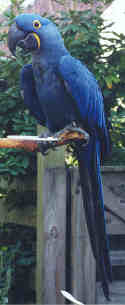
Hyacinth Macaw |
INFORMATIONAL
TIDBITS
The heavy demands of the cage-bird trade, together with loss of habitat, have resulted in
many species of parrots becoming endangered. Thousands of parrots are brought into Europe
and North America annually, both legally and illegally, and many do not survive the
journey. In most countries the capture, export, and import of parrots are strictly
regulated, but the laws are difficult to enforce. Ideally, only those parrots that have
been bred in captivity should be kept as pets. |
 |
Map of Indonesia showing the Moluccas
Islands circled in red. |
| |
INFORMATIONAL
TIDBITS
Most parrots are tropical, with only a few species reaching northern and southern
temperate areas. They are found in South America, Australia, New Guinea and the Moluccas
Islands of Indonesia. Few species inhabit Africa and mainland Asia. The most
colorful parrots are the lories, in which reds and greens predominate, but blue, purple,
brown, yellow, and black also appear. The cockatoos are mostly white, black, or peach with
touches of yellow, red, or pink. |
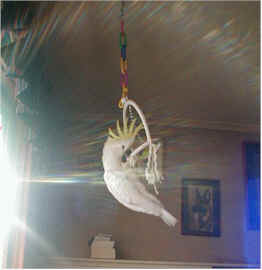 |
|
It is believed that Umbrella Cockatoos and
Moluccan Cockatoos are the most lovable and cuddly of all the Cockatoos. It also takes an
enormous amount of work and time to keep them that way. Just like cats and dogs, birds
depend on their people. It is your responsibility to provide your companion a safe happy
life.
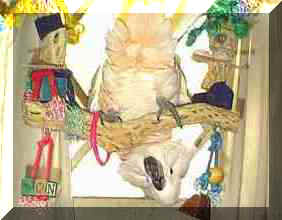 |
ROCKIE BITS Rockie needs at least 2-4 hours out of his cage and 1-2
hours of my time for holding, hugging, preening and game playing everyday,
even when I want to go out with friends,
or when I am sick. |
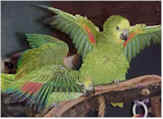 |
When you decide you want a bird, learn about them first.
You will want to start with a completely weaned baby or an adult bird. |
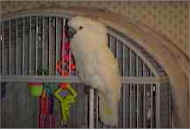 |
You need to be sure that you start from day one and establish a routine
for when the bird will be in his cage, and when he will be out. Don’t spend hours
with it for the first few days unless you plan on keeping that routine. Most birds also
require 10-12 hours of sleep every night. If you keep their cage where there is a lot of
night lights or noise, you should consider covering their cage on 3 sides to give them a
quiet spot.
INFORMATIONAL TIDBITS
Parrots have curved, hooked bills and short legs. Their toes are zygodactyl,
that is, the first and fourth are turned backward. They walk awkwardly (pigeon toed)
but are excellent climbers, often using their bills to pull themselves up to a
higher branch. In most parrots the tongue is thick and muscular, used for manipulating
seeds. Fruits, nuts, and seeds are their principal food in the wild. |
STEP UP-STEP DOWN:
You will need to teach your bird 2 basic commands. Step Up and Step Down. If you are
not comfortable offering your hand or wrist, start with a stick. This is a must to teach
your bird. When you say step up, the bird should lift its leg. In order to teach this, you
need to put the bird on a training "T"-stand, in a quiet area. Say "step
up" firmly, and place your closed hand or wrist, or stick, in from of the bird. He
may reach out with his beak to test the surface and make sure you can hold his weight.
Once on your hand, say "step down" and have him get back on the "T"
stand. Repeat for 10 minutes and always praise him for correct actions, say nothing for
wrong actions. End on a positive note, and do this several times per day.
|
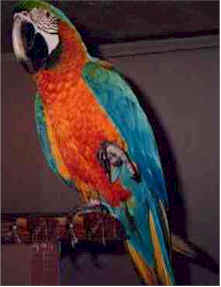
This Harlequin Macaw is ready to
step up. |
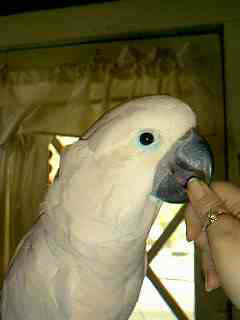 |
ABOUT BITES: The first rule is to not jerk away. If the bird bites
you and holds on, gently push toward the bird. Once the bird lets go, calmly say
"NO" and put the bird in its cage for a short time out. Do not punish the bird
as they do not understand punishment. Don’t shout or yell, or wave your hands because
birds think that is fun. Birds are very smart, they will try to bite you again to make you
do that funny stuff. Remain calm. |
THE CAGE should be at least twice as tall as the bird and twice
as wide as the bird with its wings fully open. Always get the biggest cage you can. At the
very least, the inside of the cage needs to be twice as tall as the bird, and wide enough
for the bird to completely stretch out its wings, and flap without touching the cage. It
should be powder coat painted and not bare metal. Galvanized metal is not safe for birds.
Line the cage with layers of newspaper so that you can remove a few sheets each day and
thoroughly clean the cage once a week. Do no use corn cob bedding or anything that will
hold the moisture and harbor bacteria, or that the bird could ingest. (see zinc
& birds in links below)
INFORMATIONAL TIDBITS
Virtually all parrots are hole-nesters, using holes in trees, termite mounds, rock
cavities, or ground tunnels. The main exception is the monk parakeet, of temperate South
America, which builds large nests of sticks. In the mid-20th century, many monk
parakeets were imported to the U.S. as cage birds. Some escaped, and many owners, finding
their pets unbearably noisy, simply released them. Well adapted to the temperate climate,
they bred and formed colonies in several parts of the U.S., but in most areas an effort
was made to destroy the feral populations, as this species is known to be a serious pest
in agricultural areas of its native habitat. |
TOYS: Birds need a variety of toys, wood toys to destroy,
acrylic toys to play with (physical exertion), intellectual toys-ones requiring the
bird to use mechanical and/or problem solving techniques, and
preening toys--Those that hang done with little ropes or that have little strips of cloth
for the bird to rub his back and head on them and to preen himself. You need to keep
several types in the cage and rotate them every couple weeks. Birds are very intelligent
and they get bored easily. You need to always provide them with things to entertain
themselves to prevent them from plucking out their feathers. This habit is almost
impossible to stop once it starts, and can lead to self-mutilation, where the bird
actually removes chunks of his own flesh.
(See list of Interactive games
, inexpensive toys to make and links to
toy websites below) |
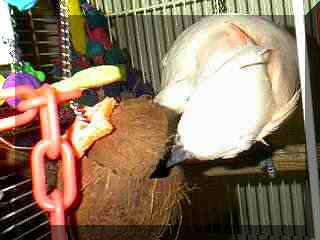 |
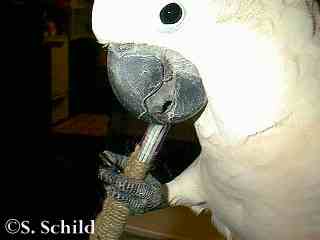 |
ROCKIE
BITS
Rockie likes to chew on TV remotes and cordless phones. When he is out of his cage. I
have to watch him all the time. He would not be safe left out alone. He would chew on
anything, including carpets, furniture, walls, and electrical cords, and possibly
electrocute himself. |
| We play peek-a-boo
with a towel and it makes him laugh. Now when I am in another room or my back is to him,
he will call out "peek-a-boo". That is his way of saying "Hey look at me, I
want to see your face". |
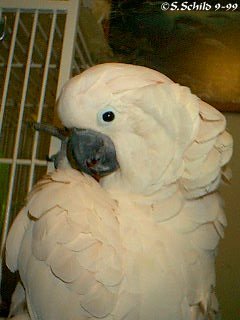 |
| NOISE: A Cockatoos’ scream
is very very loud, and can be heard down the block. They scream every morning and every
evening. Sometimes they develop behavior problems and scream all day. If you or a family
member is sensitive to loud noises, don’t get a Cockatoo. |
INFORMATIONAL TIDBITS
The ability of many parrots to imitate the human voice and other sounds is one reason for
their popularity as pets. The best of these is the African gray parrot, Psittacus
erithacus, a 12-inch gray bird with a short red tail. Experiments have shown that
individuals of this species may have cognitive abilities equal to those of porpoises and
primates. Amazons are also among the best talkers. |
|
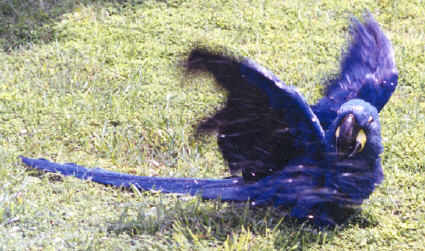 |
BATHS: Just like you, birds need baths every
day. Mist your bird with clean cool water from a clean unused spray bottle. Some birds may
enjoy getting in the shower with you. Never let your bird get chilled, wrap it gently in a
towel with its head out, while it is wet. |
Have the breeder or pet store clip the wings and check the toe nails before you bring
your bird home. You will need to have this done occasionally. If you decide to do this
yourself, be careful as you could accidentally clip a blood feather and your bird could
die. Have your veterinarian show you how to do it safely.
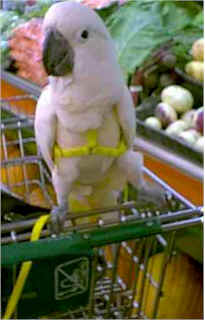 |
ROCKIE BITS
Rockie enjoys going outside or on outings. He sits real still while I
put his Feather Tether© on him. He would not be safe outside without one. If
something scared him, he could jump out of my reach and be attacked by a dog, run over by
a car, or climb up in a tree out of my reach. He would want to come back to me, but would
be scared, and may not know how to get back to me. He would be attacked by the large crows
and hawks in the area, and unable to find the right food
and may not survive.
If you need to take the bird outside, even
just to sit in the yard, use a harness and leash. Always use a carrier (like a cat
carrier) in the car, placed on the floor.
|
Your bird will molt (lose old feathers, grow new feathers) a couple
times a year. You will be much loved if you help preen the little sheaths that cover the
feathers on the top of the birds head. Be sure to stay at least 1/4" away from the
blood line, break the sheath with your fingernail and it will fall off.
You need to be extra careful during the molt to watch that the large
blood feathers on the wings and tail don’t break. They are hollow and filled with
blood. If one breaks, it will cause the bird to bleed to death. The broken feather needs
to be removed quickly. It may help to carefully wrap the bird in a towel. Grab the
bleeding feather in needle nose pliers, close to the body of the bird. Pull quickly,
straight out from the body. Keep cornstarch or flour handy to use to stop bleeding. Just
remember, a bird can bleed to death in 15 minutes or less.
STILL WILD
Keep in mind birds are still
wild animals, unlike dogs & cats, who have been bred for 1000’s of generations as
pets. Some species of birds have only been bred for captivity for just a few generations.
(What is a generation? Your mother is
a generation, her child (you) is the second generation, her grandchildren (your children)
would be the third generation.) |
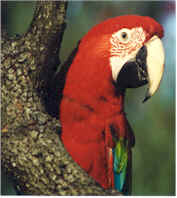 |
Birds are a flock animal. They live in groups of
16 or more. You and your family will become your birds’ flock. When you eat, they
will eat, when you sleep, they will sleep. Keep them included in family activities. Keep
their cage in a high traffic area, with one side to the wall. You can sit and laugh at the
TV together.
ROCKIE
BITS
Rockie and his cage are in the family room. He eats dinner when I do. He will scream if
he doesn’t get invited. He eats pasta, rise, some meat and vegetables, just like I
do. When I laugh, he laughs. |
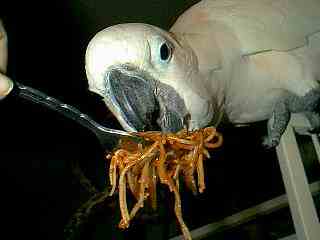 |
Never lock them away in a room by themselves. They need you.
Birds are very emotional and need to be part of your family. Locking them away because
they are messy or noisy is just like putting you in a dark room, all alone, with no one to
talk to, and it won't make them change. That is just how birds are. If you cannot handle
the loud noise or do not like to clean up after them, find another home for them. They
deserve to be loved and treated with kindness and respect.
ROCKIE
BITS
I give Rockie little jobs to do. His chores include tearing up the
envelopes from junk mail, and supervising me while I wash dishes. These are jobs he knows
and loves as it includes him as a part of my flock. |
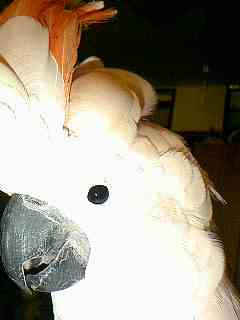 |
Cockatoo Body
Language (Fits others as well)
(This list was compiled by the good folks at Cockatoos@yahoogroups.com )
Stomping the foot - SHHHHH! Be quiet.
Clacking the beak - I am Happy.
Beak Banging - I am happy and may be looking for a mate and using tools to make my banging
noises too.
Grinding the beak - I am sleepy and content.
High pitched squeal - Come get me.
Raising the crest - What???
Fluffing with crest slightly raised - I am something special.
Full fluff, crest erect, wings extended - I am excited or aggressive.
Bobbing their head - Feed me warm moist food.
Raising a wing - Scratch me please or stay away I am afraid of you.
Fluffing the beak feathers- I am relaxing.
Hissing - I Do not like that.
Whining and crying - Pay attention to me, feed me, hold me.
Dancing and strutting - It's great to be alive. |
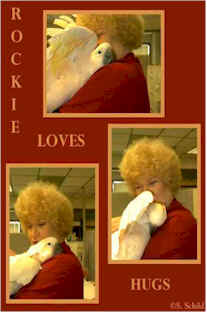 |
DIET, POISONS & SAFETY HAZARDS:
A proper diet consists of seeds, nuts, some pellets and
mostly healthy people food, such as vegies, grains like rice, and very little
fruit.
(see recipes below)
Never give your bird caffeine,(coffee, sodas), chocolate, fruit pits or
avocados.
Burning a Teflon© pan causes fumes that will kill your bird.
Any strong fumes could be deadly.
These are just a few of the dangers. (see Signs of Illness below)
There are many good books, web pages, and chat groups on these issues. (see Links below)

INTERACTIVE
GAMES YOU CAN PLAY WITH YOUR BIRD
(This list was compiled by the good folks at Cockatoos@yahogroups.com )
Remember that laughter is important for a happy bird to hear
so laugh a lot when you play these games with your bird for maximum results:
- Toss, Fetch and Catch - which are variations of games where
you use a soft, lightweight object such as a foosball or soft stuffed toy and either you
or the bird tosses it and you or the bird catches it.
- Place birdy items in a drawer the bird can get into. Like
your clean sock drawer. Hide surprises in there like walnuts and new foot toys and let the
birdy find them.
- Singing games, like Itsy Bitsy Spider, BINGO, When you're Up,
etc.
- Flying through the air games with the bird on your hand and
you steady the bird and take it through the house.
- Pick up - the bird tosses something off and you either laugh
or say Uh Oh and pick up the item over and over and over
- "I can do that too" game. The bird does something
like stretch and you imitate them and then you do something like raise your arm and see if
they will learn to imitate you.
- Blink. You blink, they blink.
- Peek a boo. Use a towel, a blanket or a cat tunnel.
- Read them children's books for entertainment, like pop-up
books and musical books, and also try to teach them colors, shapes and parts of their
body.
- Teach them to lay on their back in your lap. Then you can
tickle their tummies and give them little toys to fight with upside down.
- "Horsy is gonna get you" Tap your nails on the
surface and walk your fingers to the bird saying the above and tickle their tummy.
- Get on the floor with your bird and play with them. Take toys
and even a box of soda straws and let them dump them and play with them while you play
too. Just about every activity you do with them on the floor,even watching television
together down there, is interactive and special to the bird.
- Play Bat Bird, lay on your back and hold our bird in the air
singing bat man. One little greencheek now yells Bat Bat Bat as he plays.
- Foot play, a wonderful game you can do together. The bird
offers its foot and you shake and set it back and try to teach the bird different things
to do with the foot like wave and kiss the footie BACK TO TOP
|

INEXPENSIVE
TOYS
(This list was compiled by the good folks at Cockatoos@yahoogroups.com )
Curly Paper Ribbons (don't let your bird
swallow any)
Wooden Spoons
Large plastic LEGOS
Paper Towel Bow Ties
Cloth Bow Ties
Tiny Boxes of raisins
Brown paper bags (not for hormonal or egg laying birds)
Box with a walnut inside
Cotton sock with a walnut in it, tied at top
Stainless Steel large nuts and bolts
Stainless Steel Quick links fastened together
Wood pieces, craft store or clean scraps (untreated pine)
Soda Straws (Box and all)
Craft Sticks and popsicle sticks (clean)
Skrunchies (cloth covered ponytail holder and watch your bird does not get it on
his leg or head or body)
Rolled up newspapers through big plastic chain links
Junk Mail
Printer Paper
Untreated dried corn stalks & tamale wrappers
Wooden clothes pins (without any metal)
Ordinary cardboard box with holes in it for hide and seek
Cotton rope tied in several knots and hung
Plastic Chain
Cardboard Egg Cartons (clean) (you can hide goodies inside like
steel nuts and bolts or dried fruits)
Braided White Tissue Paper (3 sheets together)
Cleaned Rocks and Big Beads (too large to swallow)
Paper Cups and Plates (Without coating)
Plastic Lids
Clean Hair Brushes and Tooth Brushes (make sure there is no metal holding in the
bristles)
Whisk Brooms
Adding Machine Tape
Pine cones(bake at 200 for 20 minutes, leave in turned off oven 2 hours)
BACK TO TOP |

Signs
of Possible Illness in a Parrot:
(This list was compiled by the good folks at Cockatoos@yahoogroups.com )
(1) The Bird will not eat.
(2) There is discharge from nostrils or mouth.
(3) The head is tucked under the wing or rump.
(4) Diarrhea or very loose and watery droppings
(5) Weight loss is observed.
(6) Large amounts of water are being consumed.
(7) Breathing is labored, with the bird opening and closing its mouth.
Often wheezing is present.
(8) The bird is listless, maybe even sitting on the bottom of the cage.
(9) Any growths are noticed around the beak.
(10) The bird sits low on the perch covering its feet to stay warm.
(11) The bird stops talking, chirping or screaming (whatever its usual way
of communicating is.)
(12) Black poop which can be a sign of hemorrhaging.
(13) A bird that nods off to sleep and pitches forward, catching his balance
but waking up. This can be a sign of a heart problem.
(14) Staining around the vent area (fecal staining)
(15) Straining to eliminate
(16) Acts nervous
(17) Favors a limb (foot or leg)
(18) A change in color of the WHITE portion of the droppings to ANY other color
(19) Eyes appear to lose their shine
(20) White spots noticed in the mouth
(21) Frequent falls (more than normal) indicating a balance problem
(22) Beak and/or nails growing faster than usual
(23) Hardness or "pain" when touching the abdominal area
(24) Loss of powder or shine to feathers
(25) A sudden chewing or plucking problem that likely isn't caused by a
change in environment
(26) Hanging by the beak from the side of the cage, supported by the feet
(respiratory illness) BACK TO TOP |

RECIPES
BIRDIE BREAD
A healthy recipe for your special friend .
Follow the directions on a box of cornbread mix, but add to the batter
some of your birds favorite fruits (sweet bread) or veggies finely chopped or diced. Also,
you can add 1/2 cup of his healthy pellets that he may not eat normally, after soaking
them in water, to make a mush.
Mix all together, and bake. You will want to bake it slightly longer
than the package calls for. Rockie likes it more on the crunchy side.
Freeze or refrigerate it in slices that you can easily warm in the microwave for a warm
treat each day. Vary the recipe for variety. |
*BIRDIE COOKIES * (Rockie's Favorites)
(Recipe submitted by Linda Middleton of Cockatoos@yahoogroups.com)3/4
cup of Jiffy Corn Muffin Mix
1/2 cup of dried mixed veggies (or your substitute chopped fine)
1/2 cup of seed mix (or your substitute chopped fine)
Stir in a bowl with a little water to very thick consistency, the batter
should hold together and not be crumbling.
Drop by teaspoon in a circle pattern onto waxed paper set on a paper plate,
a small mound of batter about 1/2 inch wide and high, only make 6-8 at a
time. Microwave 30-40 seconds on high. Let cool completely. Lift off the
waxed paper and serve or freeze. Makes 24 perfectly sized cookies. May be frozen. (vary
ingredients as you like,chopped nuts, chopped cereal, chopped cranberries for
Thanksgiving, add a little dried fruit chopped fine, cockatiel sized colored
pellets, etc.) |
BOILED POPCORN (microwave)
(Recipe submitted by Linda Middleton of Cockatoos@yahoogroups.com)Measure
2 cups of yellow unpopped popcorn in a tall glass bowl. Cover
popcorn over with water. Cover with saran wrap, vented. Microwave on high
for 30 minutes making sure the popcorn does not run dry of water. Then
seal tight and let it stand 30 minutes. Then vent it, add more water to
cover popcorn and microwave again 30 minutes. Then seal again and let it
stand 30 minutes more. Then test it with your fingernail, you should be
able to push your nail easily into the kernel. If not, repeat another
round of cooking. When cooled, serve to parrots.
Refrigerate or freeze unused portions. |
DALLAS' FAVORITE APPLE RECIPE
(Recipe submitted by Linda Middleton of Cockatoos@yahoogroups.com)Peel
and cut into wedges about 4 large eating apples (red delicious,
jonathan, macantosh, etc.) Then put in a tall microwave safe bowl. Cover
completely with water. Cover the dish with saran wrap and vent the wrap.
Cook 17 minutes on high in the microwave and then seal the bowl tightly
with saran wrap and let stand 10 minutes on the counter.
Remove wrap and pour off the water, reserving some. With a mixer or
potato masher, smash the cooked apples. Add a dash of cinnamon. Stir.
If the mixture is too thick, thin with the reserved water. Heat in the
microwave on high about 3 minutes and serve warm, but not hot, to the
birds. (And you will like this too!)
|
BACK TO
TOP

LINKS
HEALTH AND
INFORMATIONAL LINKS |
| National Veterinary Poison
Control Center |
1-800-548-2423 $45.00 charged
to your phone bill per call, could save bird's life and a reference# with free 800 line if
you need to call back on the same problem. |
| Missing Pet List |
http://www.missingpet.net/anlost.html |
| Listing of all missing birds reported through
Bird911 |
http://members.boardhost.com/macawchat/ |
| Listing of hazards for birds |
http://www.parrotparrot.com/birdhealth/alerts.htm#top |
| All About Moluccans |
"http://www.netpets.org/birds/reference/behavioral/moluccan.html |
| For Your Bird |
http://www.foryourbird.com/
|
| Bird Rescue |
http://www.birdrescue.com |
| Common Bird Health Problems |
http://www.santaclarapethospital.com/avispec.htm
|
| Cockatoo Resource and Rescue |
http://www.cockatoos.org/ |
| Great Cockatoo Info |
http://members.xoom.com/cockatoos/ |
| WINGED WISDOM MAGAZINE ONLINE |
http://www.birdsnways.com/wisdom/ |
| PARROT NUTRITION |
http://www.ilsham.demon.co.uk/nutrition.html |
| TO PURCHASE .......G S E |
http://www.nutriteam.com/?clicktrade=228055 |
| TO PURCHASE...ALOE DETOX |
http://www.more.com/product/sku.html?itemId=418864 |
| PARROT BEHAVIOR |
http://www.parrothouse.com/behave.html |
| FIRST AID, BLEEDING, SAFE & UNSAFE FOODS,
HOUSEHOLD DANGERS, ETC. |
http://www.exoticbird.com/gillian/index.html |
| MANY RESOURCES HERE |
http://www.poozleanimus.com/ |
| BIRD POOP-OLOGY |
http://www.acstiels.com/poop-ology.htm |
| ZINC AND PARROTS |
http://www.funnyfarmexotics.com/IAS/Zn.htm |
| CROP STASIS AND VOMITING IN BABIES |
http://www.probe.net/~beakers/curry.htm |
| PARROT RESOURCES |
http://www.toolady.com/index.htm |
| AVIAN MEDICINE ONLINE |
http://www.avianmedicine.com/ |
| LEXICON OF PARROTS ( SPECIES INFO) |
http://www.papageien.de/ |
| TOP 10 BIRD KILLERS |
http://www.tampa-online.com/icarus/topten.html |
| CHAT LIST FOR COCKATOO
ALL BIRDS ARE DISCUSSED |
http://www.cockatoos@yahoogroups.com |
| TOXIC, HARMFUL, SAFE PLANTS & FOODS |
http://www.probe.net/~beakers/toxplant.htm |
| BIRD RESOURCES |
http://netvet.wustl.edu/birds.htm |
| FILL OUT FOR FREE EMERGENCY STICKER |
http://www.sthuberts.org/scoop/guest.htm |
| FEATHER PLUCKING ARTICLE |
http://www.funnyfarmexotics.com/IAS/Blanchfp.htm |
| ANOTHER FEATHER PLUCKING ARTICLE |
http://www.petbirdreport.com/complexities.shtml |
| HAZARDS |
http://www.parrotparrot.com/birdhealth/alerts.htm |
| TO REPORT LOST BIRDS |
http://www.birdhotline.com/replost.htm |
| CARING FOR YOUR NEW BIRD parrot and
wild birds |
http://www.ddc.com/~kjohnson/birdcare.htm |
| STANDARD BIRD WEIGHTS |
http://www.upatsix.com/faq/weights.htm |
| Pet Medicine Chest |
http://www.petmedicinechest.com/ |
| Pet care library for dogs, cats, birds, and exotic
pets, pet loss support resources, postcards, classified ads, fun, games, contests and cool
stuff all from this AAHA-accredited animal hospital. |
http://www.petvets.com |

BACK TO
TOP
|
 Back to Home Page
Back to Home Page![]()